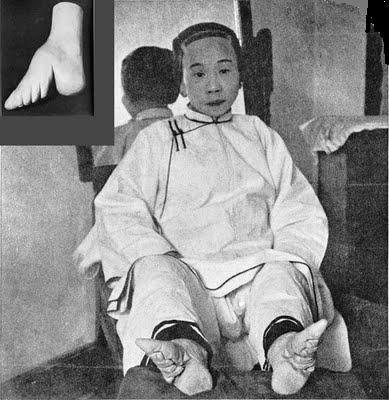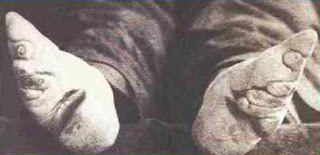An excerpt from The Three-inch Golden Lotus: a novel on foot binding by Feng Jicai
(Blogger's note: foot binding was a practice which was almost universal in China
In this scene, Fragrant Lotus, a five-year-old girl who
already has beautiful tiny feet, is initiated into womanhood by her beloved
grandmother. To start the process, she forcibly breaks the little girl’s toes
and folds them under the sole.
“Granny’s hands moved fast. She was afraid Fragrant Lotus would start to kick and scream, so she quickly completed the binding. She wrapped the bandage around the four toes, down to the arch, up over the instep, behind the heel, and then quickly forward, over the four toes once again. . . Fragrant Lotus’ mind was filled with waves of pain and pinching, folding and contortion. . . The four toes, now next to the arch, were locked firmly in place, as if by metal bands. They were unable to move, even a minute fraction of an inch.
“. . . She set about collecting shards of broken bowls, spread them on the ground, and smashed them into small, sharp bits. The next time she rebound Fragrant Lotus’ feet, she put the bits of porcelain inside the bandages, along the soles of her feet. When Fragrant Lotus walked, the pottery bits cut into her skin. . . The cut feet suffocated by the bandages became swollen, inflamed, and pus formed in the wounds. Whenever the bindings were changed, the old bandage had to be ripped off, tearing off pus and chunks of rotten flesh. This was an old method in the north
ENOUGH! We won’t get into the way Granny pulls out Fragrant Lotus’ toenails and pounds her feet with a rolling pin to make them more malleable. Though I am sure Jicai did his research with the utmost care (it matches everything I’ve ever found on the subject), at a certain point it becomes too headspinningly horrendous to even take in. How many millions of little girls had their childhood stolen from them in this way, forced to live the rest of their lives with a literally crippling deformity?
But even this isn’t the worst. Jicai also delves into the creepy fetishes men developed around bound feet, which were sometimes unwrapped and “played with” in the marriage bed. Foot competitions, in which feet were judged on size and shape (the smaller and pointier the better) were a common diversion, with women hiding behind screens so that only their deformed feet showed in their three-or-four inch, gorgeously-embroidered, teeteringly high-heeled shoes.
Because of her exquisitely-bound feet, Fragrant Lotus has “married up” into a wealthy family with a typical foot obsession. An impromptu foot contest springs up when a number of perverted old men show up to indulge their fetish. Mr. Lu, a self-appointed expert on the subject, begins to expound:
“Small feet are beautiful or ugly based on their overall appearance, which can be further divided into two elements: shape and form. Let us discuss shape first. There are six terms to describe shape: short, narrow, thin, smooth, upright, and pointed. Short refers to the foot’s length from back to front, and it should be short, not long. Narrow refers to the breadth of the foot from side to side, and it should be narrow, not wide. . . "
"Pointed refers to the toes, which should not be blunt but should come to a sharp point. If they have a slight upward turn, they are even more seductive. However, the degree of upturn should be just right. Too much will cause the point to stand upright, like a scorpion’s tail; too little and it will droop downward, like a rat’s tail. Neither of these will do. And that, gentlemen, completes the discussion of the shape of the lotus.”
It goes on and on from there, for pages and pages, as various points of confirmation are discussed in detail as if the men are talking about flower varieties or dog breeds. The longer you think about this, the worse it gets: these crushed feet are being celebrated, the women’s lifelong crippling lifted up as rare beauty. The most unbelievable aspect of all this is the true meaning of the term “fragrant”: what it comes down to, as far as I can tell, is the horrid whiff of dead flesh coming from the rotting toes.
From a foot binding site come these startling revelations:
“Men who were turned on by bound feet were referred to as “lotus lovers”. They were aroused by the mysterious feet and were thrilled when the cotton covers were taken off. They inhaled the fragrant aroma and took delight in smelling the bared flesh. The husbands would fondle the foot in the palms of his hand before gradually caressing it with his mouth. He would place watermelon seeds or almonds between the toes before eating them from the woman’s foot. Beside these strange fetishes some men would drink the water that had previously been used to bathe the feet. The bound feet would be treasured like gold.”
When Fragrant Lotus loses the foot competition, not by inferior feet but a cheap pair of shoes, she decides to commit suicide: “In the Tong family if your feet were bad, you were finished. This family was like a chessboard, and bound feet were the individual chessmen. One false move and the game changed completely.”
Her only solution is to consult with a foot binding expert who says her feet are not "bowed" enough to be truly beautiful and must be rebound. ("Bowed" refers to the buckling upward of the crushed instep, forcing the front of the ankle to bulge outward.) Thus she experiences the torture of her girlhood all over again in order to gain favor in her own family.
Corsets, high heels, female circumcision, clitoridectomy, where does it stop? Now women are having surgery on their feet to “correct” problems that might keep them from wearing the five-inch skyscraper heels that are currently in fashion. In fact, the newest invention is the "ballet" heel in which the wearer literally walks on the ends of her toes with seven-inch stilts under her heels.
All in the name of fashion, but why? Do women do this for each other? Why are men so afraid of women? Why won’t they let us walk, breathe, have an orgasm? Why was being deformed and crippled such a sexual turn-on in an advanced civilization for a thousand years? Do you really think all this pain is part of the past, has come to an end? Why do women collude with men in taking on so much pain in order to be “beautiful”? What’s beautiful? And why?
Dear Sir or Madam, will you read my book
It took me years to write, will you take a look
Order The Glass Character from:
http://www.amazon.com/-/e/B001K7NGDA
Barnes & Noble
Thistledown Press
















































